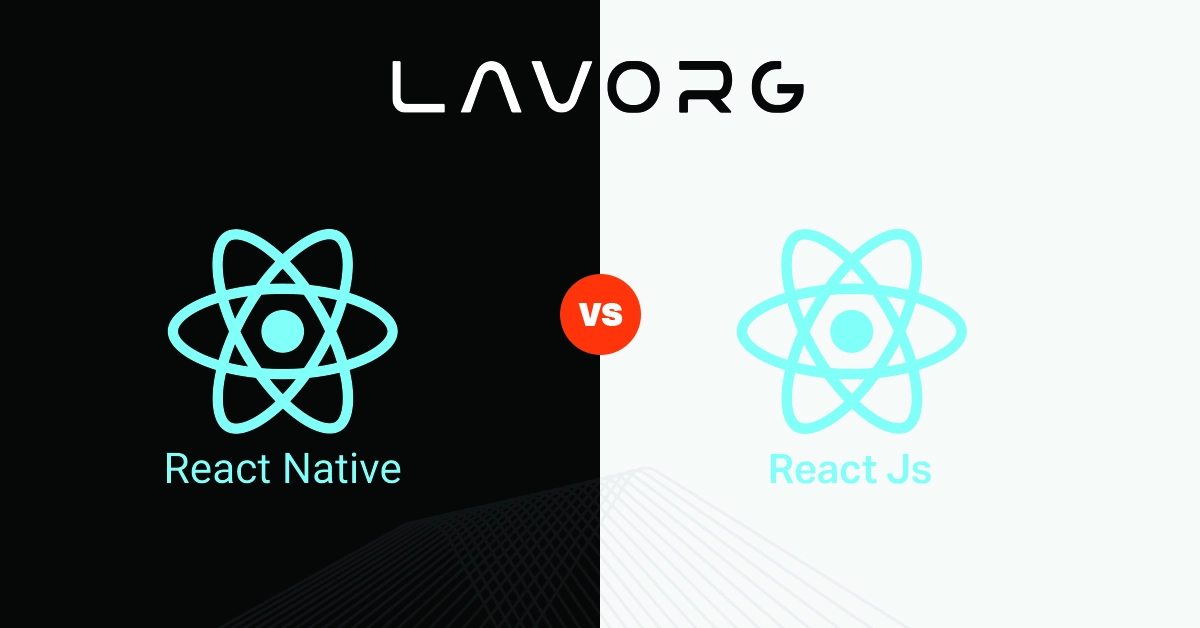
Introduction to React and React Native
In the ever-changing world of mobile and web development, a lot of perplexing things keep happening. Confusion is an element that is inevitable to avoid in the entirety of the human lifecycle, and some concepts with similar names are added to the same list. Whenever you hear something new, your first instinct is to Google every characteristic about it. We then concentrate on understanding its primary characteristics, advantages and disadvantages, and much more. A similar situation happens with the topic we are going to cover in this blog. It’s quite easy to get confused between ReactJS and React Native, especially for people with non-technical backgrounds.
In the frantic world of web and mobile development, two formidable tools have emerged as frontrunners: ReactJS and React Native. Both technologies are based on Facebook’s open-source project and share essential concepts, but they are designed for different platforms. ReactJS revolutionized web user interfaces, whereas React Native revolutionized mobile app development.
In this blog, we’ll go over both technologies in depth, highlighting their common fundamental concepts, important differences, use cases, and future developments. Understanding these technologies will enable you to make informed development decisions, whether you’re creating web user interfaces or mobile apps.
What is React?
To primarily define the major differences between ReactJS and React Native, you must first understand them individually. React, React.Js, or ReactJs is a prominent Jawa Script that is used to craft single-page mobile and web apps. It was launched in 2013, more than a decade ago, and has since been used by many startups and MNCs for all of their development activities. Companies like-
- NY Times
- Dropbox
have used React to create fantastic user experiences. It provides developers with a disciplined approach to generating reusable user interface elements, allowing for the rapid creation of complex online applications. ReactJS enhances efficiency by limiting DOM manipulation and updating only the relevant components using a virtual DOM and a unidirectional data flow.
What are the features of React?
- Continuously evolving and upgraded at frequent intervals by developers globally.
- Provides a real-time overview of change, reducing the possibility of catastrophic errors.
- Provides precise SEO capabilities, which allows for more productive and result-oriented indexing.
- Includes Document Object Model (DOM), which is known for its speed and advanced performance.
- Assists you in creating user-friendly applications with minimal coding.
- The JawaScript syntax helps in quicker utilization of the portal and develops further functionalities.
- Offers faster updates with data changes along with a declarative coding view, resulting in better readability and debugging on time.
- React provides easy HTML and full library access while maintaining a fast, productive, and interactive user interface.
Benefits of React
Many organizations use ReactJS due to its varied capabilities-
- Developers who have a strong knowledge of JavaScript can easily learn and craft apps using React.
- React’s virtual DOM provides fast performance because it is stored in memory; upgrades to any component do not affect the DOM, ensuring flawless implementation.
- It provides renewable elements, removing the need to build everything from scratch for each project.
- ReactJS has a large and active community, as well as a comprehensive set of development tools.
- It provides dynamic apps with less coding and more functionality.
Hire the best React Development company
What is React Native?
When you’re decoding ReactJS vs. React Native performance, it’s vital to understand what React Native does accurately. React Native is a framework designed for building mobile apps using JavaScript and React’s declarative syntax. Launched way back in 2015, this open-source framework curated by Facebook is one of the finest libraries for developing native mobile apps for several portals inclusive of iOS, Windows, and Android. React Native also offers a variety of reusable components that run on different platforms.
React Native is mostly used for developing UI components for mobile apps. This product is used globally in over 25,000 apps. Instagram, Facebook Ads, Bloomberg, Walmart, and SoundCloud are some popular apps that use React Native. React Native aids in the creation of truly native components for improved app performance and a fantastic user experience.
Features of React Native
- Native offers cross-platform functionality for specific portal codes. This enables your application to perform effortlessly on different platforms without any code changes, saving a ton of time.
- With an easy-to-memorize structure, any Front-end developer with a decent amount of JavaScript proficiency can work with it to curate apps.
- Apart from easy integration with any mobile app, its reusable elements and readily accessible libraries help in a significant reduction of coding time.
- Along with impeccable JavaScript compatibility, its lax structure makes development tasks quicker.
- It also has a customizable user interface and an interactive design.
- You can check for any changes in code in real time during development.
The Benefits of Using React Native for Mobile Application Development
- Native is easier to learn and also has an active community that shares insights and latest trends constantly.
- Upgrades and new features are added regularly.
- It offers you the leverage of utilizing your JavaScript knowledge to produce native mobile apps.
- Native provides code that is easily accessible to everyone, saving you time and money during the development stage.
What are the pros and cons of React and React Native
Some of the Pros and Cons of ReactJS and React Native are as follows:
Advantages of React
- ReactJS has a component-based architecture, which makes it easier to organize and reuse UI components across the application.
- It employs a virtual DOM, which boosts efficiency by eliminating direct manipulation of the actual DOM, resulting in faster rendering.
- React uses declarative syntax, which allows developers to express how the UI should look based on the application state, making the code more predictable and understandable.
- It has a large ecosystem of libraries and packages, which makes it easy to discover solutions to diverse tasks.
- React’s server-side rendering (SSR) improves SEO by rendering initial content on the server, increasing search engine visibility.
- Additionally, it has a large and active community, providing abundant resources, tutorials, and community-driven support.
Disadvantages of React
- Because of issues such as JSX and component lifecycles, the learning curve for newcomers can be tough.
- Developing complicated features may necessitate additional code, perhaps resulting in bigger file sizes.
- Since ReactJS is primarily intended for creating web user interfaces, it is not suitable for constructing mobile apps without the use of other tools.
- It does not have direct access to native device functionalities, which may necessitate the use of extra modules or third-party libraries.
Advantages of React Native
- It enables code reuse between platforms (iOS and Android), lowering development time.
- React Native apps use native components to provide native-like speed and crisper animations and interactions.
- Hot reloading allows developers to see code changes immediately, which speeds up the development and debugging process.
- React Native comes with a plethora of pre-built components that closely resemble native elements, reducing development time.
- You can build apps for both the iOS and Android platforms using a single codebase, decreasing development time.
- React Native, like ReactJS, has an active and expanding community that provides support and resources.
Disadvantages of React Native
- Using third-party libraries for certain functions might occasionally result in compatibility concerns or unexpected behavior.
- Complex custom UI elements may necessitate more effort than custom UI built in a platform-specific language.
- In some cases, you may need to add native modules or write native code for particular functionalities.
- While familiarity with React is a bonus, mastering React Native’s native modules and navigation might be difficult.
Which one should I choose?
Even though we have briefly discussed the pros and cons of both these products, let us learn their shared core concepts for them-Both systems use a virtual version of the actual DOM, which reduces the need for frequent modifications and improves performance. The modular approach enables developers to construct self-contained components that may be utilized throughout the program. ReactJS and React Native use declarative syntax, in which developers declare how they want the UI to look, and the frameworks handle the implementation
Choose React development services if you want to design interactive user interfaces for websites and are focusing on web development. If you’re interested in mobile app development, choose React Native, which allows you to create native-like experiences on both iOS and Android devices using a single codebase.
Conclusion
At the end of this blog, we can safely derive the conclusion, that both of these technologies are pretty crucial and have their own merits. There’s no requirement for us to compare ReactJS and React Native due to their technical differences. Although, ReactJS remains a winner if what you want is to curate interactive and dynamic web user interfaces, while React Native is a fundamentally solid choice if you’re looking to offer cross-platform capabilities and a native feel. The goal and nature of your project will ultimately determine your choice between ReactJS and React Native.
Whether you’re creating web interfaces or mobile apps, these two cutting-edge technologies enable developers to create extraordinary user experiences. With a diverse range of seasoned developers at your disposal, including the expertise of React Native App Development Services and the expertise of hireable React developers, you’re ready to embark on your development journey with the perfect team by your side every step of the way.
ReactJS and React Native are powerful tools, each excelling in its domain. By embracing their shared fundamental concepts and understanding their distinctions, you’ll be able to maximize the capabilities of ReactJS and React Native to design amazing user interfaces and mobile apps that respond to the ever-changing needs of today’s digital marketplace.
Looking to Hire Remote React Developers for your project?

Software Development Outsourcing to Germany: Is It Worth It?
Germany is one of the most advanced and technologically-driven countries in Europe and globally. It is home to companies such as Siemens and SAP that have contributed towards digital transformation, tech advancements and enhanced productivity in enterprises and houses. It is no surprise that the country owns one of the biggest software development networks. You will find some bigwigs in development and highly experienced developers boarding your software requirements.
